Swope Park
Introduction
Text-to-speech Audio
Established in 1896, Swope Park was the second largest municipal park in the United States. Kansas City land developer and philanthropist Thomas H. “Colonel” Swope purchased 1,334 acres of land outside of city limits and donated it to the city for public use. It is perhaps the most prominent contribution to the City Beautiful Movement presented by George Kessler, known for designing Kansas City’s parks and boulevard system. The land featured a network of beautiful and historic corridors that shaped the park's development, as well as large wooded areas and a fine rock quarry. By 1910, the park included a golf course, picnic areas, a lake and lagoon, athletic amenities, and a bird and animal building that became the Kansas City Zoo. Over the years, more land was acquired, reaching a total of 1,805 acres. Today, Swope Park hosts nearly 2 million visitors annually and additionally offers a community garden, Starlight Theatre, the Lakeside Nature Center, and much more. The continual development of the park over the years has provided an economic stimulus to an otherwise underserved area.
Images
Map of Swope Park c. 1911. Photo courtesy of Missouri Valley Special Collections, Kansas City Public Library
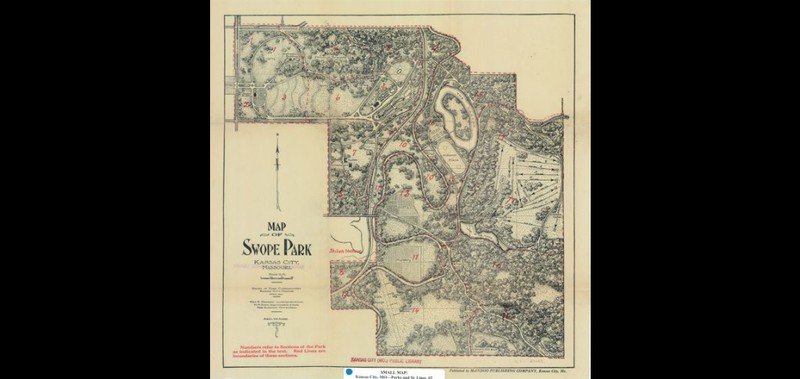
Aerial view of Swope Park gardens c. 1920. Photo courtesy of Missouri Valley Special Collections, Kansas City Public Library
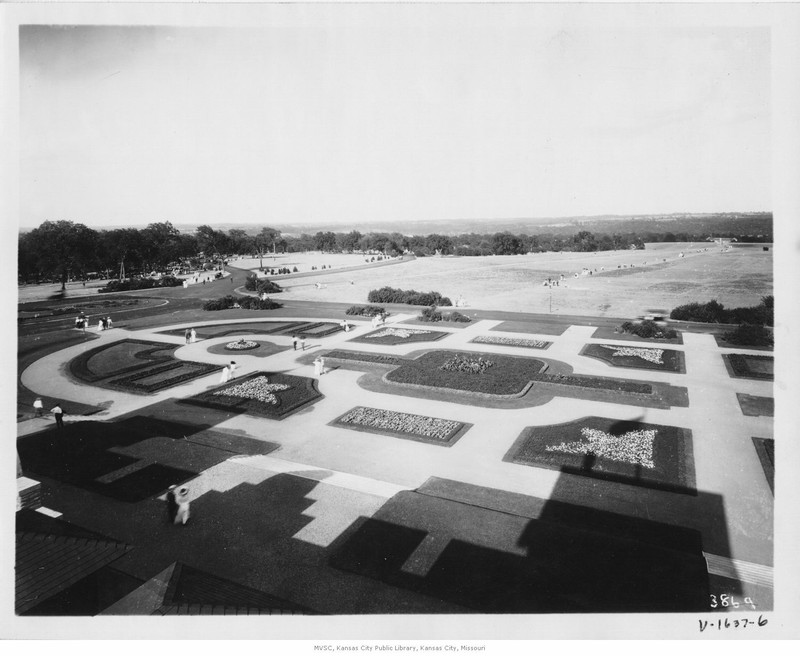
The Swope Park suspension bridge c. 1908. Note this bridge is now part of the Africa exhibit for the Kansas City Zoo. Photo courtesy of Missouri Valley Special Collections, Kansas City Public Library
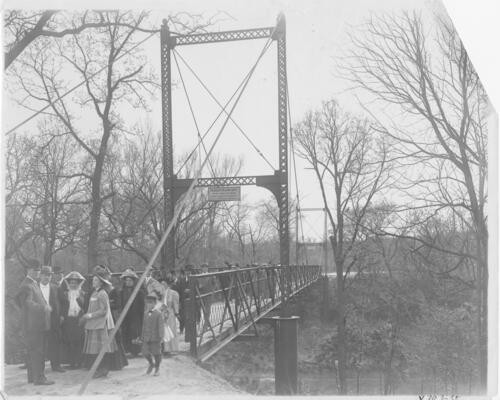
Photo in profile of Thomas H. Swope. Photo courtesy of Missouri Valley Special Collections, Kansas City Public Library
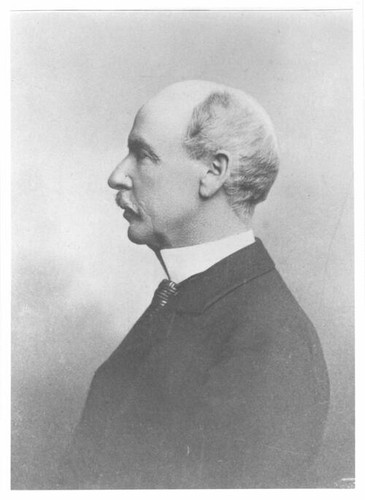
Portrait of Thomas H. Swope c. 1906. Photo courtesy of Missouri Valley Special Collections, Kansas City Public Library
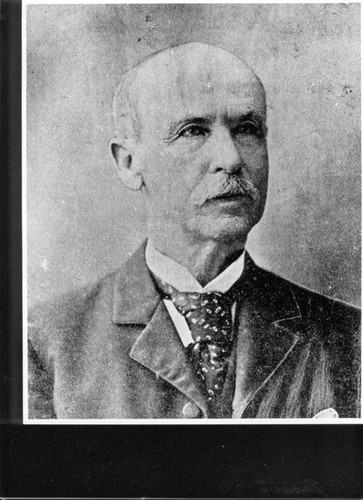
Backstory and Context
Text-to-speech Audio
In 1896, Kansas City philanthropist and real estate investor Thomas H. Swope (1827-1909) donated 1,334 acres (about 2 square miles) of land to the city for public use. The historic boulevards and parkways of this area had already been planned in the 1893 City Beautiful Movement presented by landscape architect and engineer George Kessler, which helped shape the park's development. On June 25, 1896, an opening ceremony was held called the “Swope Park Jubilee.” There was so much excitement surrounding the park that then-Mayor James M. Jones declared the day a civic holiday and 18,000 people attended. At the time, this was the second largest municipal park in the United States.
By 1907, Swope Park included a shelter and flower garden at the northwest entrance; tennis courts; an athletic field; picnic areas; a rifle range; a golf course; and a 217-foot pedestrian suspension bridge over the Blue River. The land also featured wooded trails and a rock quarry. With approval from the City Council in 1909, a bird and animal house was built, and used fieldstone supplied from the park's quarry. The zoo opened and was dedicated December 13, 1909. The lagoon and Lake of the Woods were completed around the same time. The city acquired more land over time, increasing the park's total to 1,805 acres.
Today, the park hosts nearly 2 million visitors annually. It features multiple covered picnic shelters; fountains and monuments; an off-leash dog park; the “Go Ape!” zipline adventure park; a pool; the Swope Park Memorial Golf Course and Heart of America Golf Course with Tom Watson Golf Academy; the Kansas City Zoo; Lakeside Nature Center; a disc golf course; Kansas City Community Gardens; Starlight Theatre; a soccer village; Lake of the Woods recreation area; and wooded trails.
Thomas Hunton Swope (1827-1909)
Thomas H. “Colonel” Swope was born on October 21, 1827 in Kentucky. He was a Yale graduate and speculated in mining and real estate investments in New York early on. In 1855 he headed west as the Kansas Territory opened, first investing in real estate in Saint Louis before settling in the Kansas City area in 1857. Here, he purchased an abundance of land, becoming the largest individual landowner in Kansas City. Swope was a lifelong bachelor and lived in a mansion with several members of his extended family near Independence, Missouri.
Colonel Swope became very successful but remained generous. His most famous legacy was the donation of land for Swope Park in 1896. In 1905, he donated a 4.5-acre tract of land at 23rd and Cherry for a new hospital which had been approved for a bond two years earlier. General Hospital opened in October 1908, offering 600 beds and free municipal healthcare for the indigent; one of the only cities in the country to do so. Thomas Hunton Swope died of a cerebral hemorrhage on October 3, 1909. He was held in high regard for his contributions to the city, as public schools were dismissed at noon and patrons lined the streets in his honor for his services on October 8. On this day, his body lay in state in the rotunda at the Kansas City Public Library and funeral services were held at Grace Episcopal Church. However, his body remained in a holding vault until his wish of a Memorial was built in Swope Park and was laid to rest on April 8, 1918.
Swope’s sudden and tragic death, in conjunction with a series of other deaths and illness in the family mansion, led to a murder investigation of the family physician, Dr. Bennett Hyde. The first incident occurred two days prior to Colonel Swope’s death when a cousin, who happened to be the executor of Swope’s will, died suddenly. Two months later, an outbreak of illness swept the Swope mansion, as Typhoid fever took the life of his nephew. Investigators quickly realized a motive for Dr. Hyde as he had married Swope’s niece Francis a few months prior, and because Swope had no direct kin, his extended family would become the heir to his multi-million dollar fortune. Hyde was indicted for murder when investigators revealed he had recently purchased cyanide capsules and samples of typhoid, as well as an autopsy report of Swope’s exhumed body that showed traces of “some convulsive and paralyzing poison” in his system. On May 16, 1910, Bennett Hyde was convicted of murder by a jury. However, during the appeals process that verdict was overturned. After several more trials, prosecutors were unable to get another guilty verdict, and after 7 years Hyde was cleared of suspicion of murders. The trials ruined his career and he eventually divorced Francis. He died in 1934 never having confessed to the tragic events, leaving the true cause of Swope’s death unknown to this day.
Sources
Swope Park, KC Parks. Accessed February 11th 2022. https://kcparks.org/places/swope-park/.
Jezak Ford, Susan. Biography of Thomas H. Swope (1827-1909), Land Developer and Philanthropist, Kansas City Public Library. Accessed February 11th 2022. https://kchistory.org/islandora/object/kchistory%253A115415.
Swope Park Lagoon, Kansas City Public Library. Accessed February 11th 2022. https://kchistory.org/image/swope-park-lagoon-0.
Lee, Janice. General Hospital Profile, Kansas City Public Library. Accessed February 11th 2022. https://kchistory.org/islandora/object/kchistory%253A115141.
Swope Park, Shelter House and Sunken Garden, Kansas City Public Library. Accessed February 11th 2022. https://kchistory.org/islandora/object/kchistory%253A108749.
https://kchistory.org/image/map-swope-park-kansas-city-missouri?solr_nav%5Bid%5D=ec057526bc19b2738acf&solr_nav%5Bpage%5D=0&solr_nav%5Boffset%5D=4
https://kchistory.org/image/swope-park-garden-0?solr_nav%5Bid%5D=830ad5a05904a58f0c25&solr_nav%5Bpage%5D=0&solr_nav%5Boffset%5D=0
https://kchistory.org/image/suspension-bridge-swope-park?solr_nav%5Bid%5D=af437092f3a9cf782dcc&solr_nav%5Bpage%5D=0&solr_nav%5Boffset%5D=2
https://kchistory.org/image/thomas-swope-0?solr_nav%5Bid%5D=8082bb7f36f0c97592be&solr_nav%5Bpage%5D=0&solr_nav%5Boffset%5D=2
https://kchistory.org/image/thomas-swope?solr_nav%5Bid%5D=8082bb7f36f0c97592be&solr_nav%5Bpage%5D=0&solr_nav%5Boffset%5D=1
